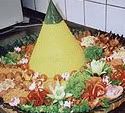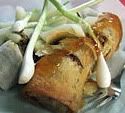
Culture of Indonesia
 Indonesia has around 300 ethnic groups, each with cultural differences developed over centuries, and influenced by Indian, Arabic, Chinese, Malay, and European sources. Traditional Javanese and Balinese dances, for example, contain aspects of Hindu culture and mythology, as do wayang kulit (shadow puppet) performances. Textiles such as batik, ikat and songket are created across Indonesia in styles that vary by region. The most dominant influences on Indonesian architecture have traditionally been Indian; however, Chinese, Arab, and European architectural influences have been significant. The most popular sports in Indonesia are badminton and football; Liga Indonesia is the country's premier football club league. Traditional sports include sepak takraw, and bull racing in Madura. In areas with a history of tribal warfare, mock fighting contests are held, such as, caci in Flores, and pasola in Sumba. Pencak Silat is an Indonesian martial art. Sports in Indonesia are generally male-orientated and spectator sports are often associated with illegal gambling.
Indonesia has around 300 ethnic groups, each with cultural differences developed over centuries, and influenced by Indian, Arabic, Chinese, Malay, and European sources. Traditional Javanese and Balinese dances, for example, contain aspects of Hindu culture and mythology, as do wayang kulit (shadow puppet) performances. Textiles such as batik, ikat and songket are created across Indonesia in styles that vary by region. The most dominant influences on Indonesian architecture have traditionally been Indian; however, Chinese, Arab, and European architectural influences have been significant. The most popular sports in Indonesia are badminton and football; Liga Indonesia is the country's premier football club league. Traditional sports include sepak takraw, and bull racing in Madura. In areas with a history of tribal warfare, mock fighting contests are held, such as, caci in Flores, and pasola in Sumba. Pencak Silat is an Indonesian martial art. Sports in Indonesia are generally male-orientated and spectator sports are often associated with illegal gambling.Indonesian cuisine varies by region and is based on Chinese, European, Middle Eastern, and Indian precedents. Rice is the main staple food and is served with side dishes of meat and vegetables. Spices (notably chili), coconut milk, fish and chicken are fundamental ingredients. Indonesian traditional music includes gamelan and keroncong. Dangdut is a popular contemporary genre of pop music that draws influence from Arabic, Indian, and Malay folk music. The Indonesian film industry's popularity peaked in the 1980s and dominated cinemas in Indonesia, although it declined significantly in the early 1990s. Between 2000 and 2005, the number of Indonesian films released each year has steadily increased.
The oldest evidence of writing in Indonesia is a series of Sanskrit inscriptions dated to the 5th century CE. Important figures in modern Indonesian literature include: Dutch author Multatuli, who criticized treatment of the Indonesians under Dutch colonial rule; Sumatrans Muhammad Yamin and Hamka, who were influential pre-independence nationalist writers and politicians; and proletarian writer Pramoedya Ananta Toer, Indonesia's most famous novelist. Many of Indonesia's peoples have strongly rooted oral traditions, which help to define and preserve their cultural identities. Media freedom in Indonesia increased considerably after the end of President Suharto's rule, during which the now-defunct Ministry of Information monitored and controlled domestic media, and restricted foreign media. The TV market includes ten national commercial networks, and provincial networks that compete with public TVRI. Private radio stations carry their own news bulletins and foreign broadcasters supply programs. At a reported 25 million users in 2008, Internet usage is limited to a minority of the population, approximately 10.5%. (source)



















0 comments:
Post a Comment